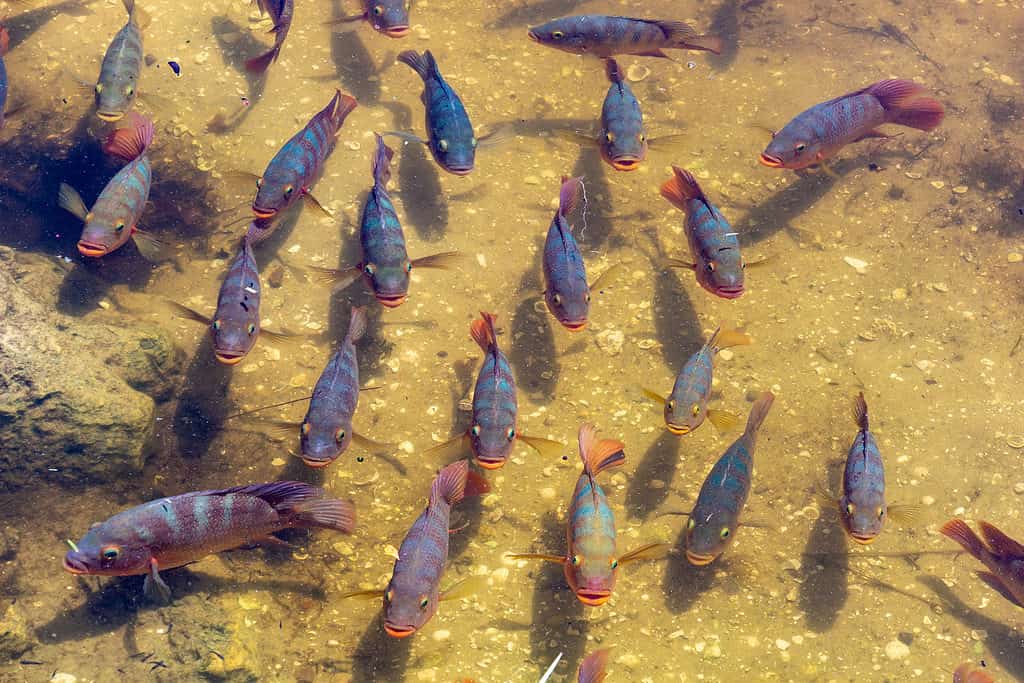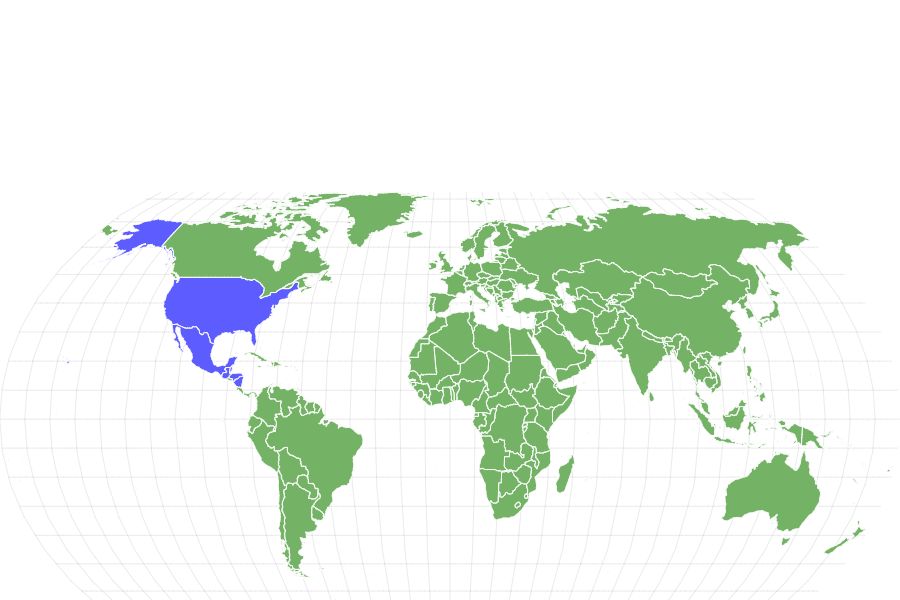Mayan Cichlid
Mayheros urophthalmus
Mayan cichlids live longer in captivity than they do in the wild.
Advertisement
Mayan Cichlid Facts
- Prey
- Fish, snails, crustaceans
- Main Prey
- Smaller fish
- Name Of Young
- Fry
- Group Behavior
- Breeding pair
- Fun Fact
- Mayan cichlids live longer in captivity than they do in the wild.
- Distinctive Feature
- Vertical stripes
- Other Name(s)
- Mexican mojarra
- Temperament
- Aggressive and territorial
- Optimum pH Level
- 6.0 to 8.0
- Average Spawn Size
- 100 to 150 eggs
- Predators
- White egret, reptiles, and larger fish.
- Diet
- Omnivore
- Lifestyle
- Diurnal
- Crepuscular
- Favorite Food
- Smaller fish
- Type
- Cichlid
- Common Name
- Mayan cichlid
- Origin
- Central American Atlantic Slopes
- Number Of Species
- 1
- Location
- Mexico, Florida, Honduras, Belize, Guatemala, Nicaragua
- Nesting Location
- Mangrove roots or substrate
Mayan Cichlid Physical Characteristics
- Color
- Brown
- Yellow
- Red
- Orange
- Silver
- Pink
- Olive
View all of the Mayan Cichlid images!
Mayan Cichlid Summary
Mayan cichlids, also known as Mexican mojarra, are a highly territorial species of fish from the American cichlid family. These fish can be found in the wild in Central America and in captivity in different parts of the world, where they are kept as pets in freshwater or brackish aquariums.
The Mayan cichlid originates from Central American Atlantic slope waters, where they inhabit freshwater swamps, lakes, and rivers or coastal lagoons. These fish are found in various colors, making them exciting to own in captivity.
3 Mayan Cichlid Facts
- Mayan cichlids are tolerant to hypoxia since their natural habitat is at high altitudes.
- The first non-indigenous discovery was in South Florida in 1983.
- Mayan cichlids can tolerate slightly lower temperatures than other cichlids, although they are still considered tropical fish and prefer warmer temperatures.
Classification and Scientific Name
Mayan cichlids, scientifically known as Mayaheros urophthalmus, belong to the Cichlidae family in the Mayaheros genus of cichlids native to Central America. There is only one species of Mayan cichlid.
Appearance

Mayan cichlids can be found in yellow, olive, silver, red, brown, and orange.
©Sunshower Shots/Shutterstock.com
The Mayan cichlid has an interesting appearance, with their most distinctive feature being stripes or striking patterns on their bodies. These are relatively large cichlids that reach an adult size of 12 inches and can weigh up to 2.4 pounds on average.
They are very colorful cichlids that can be found in yellow, olive, silver, red, brown, and orange. The most common colors in Mayan cichlids are an olive-brown or silver, with light brown grading. Breeding males will develop a pink-colored throat, while females and non-breeding males will have a light pink throat.
Their most distinctive feature is a set of vertical stripes or broken lateral lines that have an olive-brown coloration leading from their head to the base of their tail, along with a ring at the start of their tail.
Mayan cichlids have multiple colors in their bodies, and their shiny scales give them a luminescent appearance that glimmers under bright lighting. These fish have defined dorsal fins that stretch from the base of their neck to the base of their caudal (tail) fin. Males have a slightly pointed dorsal fin than females. Most of their fins are spiny and sharp, so they may get stuck in netting or leave tiny scrapes on your hands during handling. The anal and tail fin are generally soft.
Mayan Cichlid Distribution, Population, and Habitat
Distribution
Mayan cichlids are native to tropical Central America to the Atlantic slope waters, but they were first recorded to be found in Florida Bay in the Everglades National Park.
They are distributed from Lake Okeechobee and the connecting St. Lucie Canal in Florida. You can find them distributed in southeastern Mexico and aquatic habitats from the Caribbean seas to Belize, Guatemala, Nicaragua, Honduras, and the Yucatan Peninsula.
Population
According to the International Union for Conservation of Nature red list, their population size is labeled as the least concern.
Habitat
A Mayan cichlid‘s natural habitat is quite diverse, and they inhabit both freshwater and brackish water conditions at high altitudes. These bodies of water include lakes, ponds, slow-moving rivers, saltwater lagoons, rocky coastlines, and swamps. However, it seems they prefer freshwater, although they can tolerate high salinity or brackish water conditions at around 15 parts per thousand. Scientists have found these cichlids breeding in salty waters, even though most inhabit freshwater.
Their ideal wild habitat will have a muddy substrate with abundant vegetation and rocks. Most can be found in waters with plenty of dissolved oxygen. However, they also adapt to live in low-oxygen conditions at high altitudes.
Most of their habitats are tropical, so they prefer warm, freshwaters. In captivity, these tropical temperatures can be replicated by using an aquarium heater. It is recommended to replicate their natural habitat in captivity, requiring a large aquarium with a minimum of 55 gallons. However, as they grow, the aquarium should be upgraded accordingly. Live plants and a sandy substrate are ideal for these cichlids, and a neutral to alkaline pH of 6.0-8.0 is preferred.
Mayan Cichlid Predators and Prey
Prey
Mayan cichlids are omnivores that eat a variety of plant and animal-based matter in their diet. Mayan cichlids eat crustaceans, small fish, snails, and algae in the wild. They can also be found consuming detritus or deceased fish and invertebrates.
In captivity, they should eat omnivorous cichlid food high in protein. Pelleted foods are ideal as a staple commercial food, and their diet should ideally be supplemented with live or freeze-dried worms or shrimp.
Predators
The main predators they face are snowy egrets, reptiles, and other large and carnivorous fish. Mayan cichlids are known to be aggressive and territorial, but they cannot defend themselves against much larger fish. Even in captivity, the Mayan cichlid should be kept with compatible tank mates that will not harm them or vice versa. Smaller fish may be seen as prey, and they will eat any fish they can fit into their mouths.
Reproduction and Lifespan
During breeding, you should expect to see their aggressiveness increase, and they become highly territorial over their nests and fry (young fish). These cichlids can have multiple broods a year, and the females lay up to 150 eggs along the substrate or nest during the breeding season, typically from March-June.
The parents will then guard the fry for 4-6 weeks in a nest they create. However, some might eat the fry. As breeding season starts, Mayan cichlids will begin constructing a nest before spawning. In the wild, these nests are around four inches deep and found in the roots of mangroves or amongst rocks in the substrate. They are protective over their eggs and display aggression toward other fish by chasing them away or fin-nipping.
Their average lifespan is up to 10 years, although it is not uncommon for them to live 12 years when well cared for in captivity.
Mayan Cichlid in Fishing and Cooking
Mayan cichlids can be caught by fishing using spinning rods and bait. The ideal bait to catch these fish includes freshwater shrimp, worms, young minnows, or any prey animals these fish would catch. You will have better success catching Mayan cichlids from May-July during their breeding season. Fishing should occur in regulated and legal areas and can be fished in southern parts of Florida and south Texas in the U.S.
You can catch Mayan cichlids for cooking, and these large fish can be gutted and pan-fried in white wine sauces with garlic and lemon to create a tasty dish.
Related Animals
View all 164 animals that start with MMayan Cichlid FAQs (Frequently Asked Questions)
Where are Mayan cichlids found?
Mayan cichlids can be found in Central America, where they inhabit freshwater and brackish water from south-eastern Mexico to Florida.
They inhabit mangroves, rivers, lakes, marshes, coastal areas, and ponds. The water conditions should be tropical, with a neutral to alkaline pH with vegetation, plant roots, and rocks.
How big do Mayan cichlids get?
Mayan cichlids are relatively large fish that reach an adult size of 12 inches and weigh between 2-2.4 pounds. Some wild specimens can exceed 12 inches in size.
What do Mayan cichlids eat?
Mayan cichlids are omnivores and consume small fish, crustaceans, algae, plants, and insects.
In captivity, they should be fed omnivorous cichlid pelleted food twice a day.
What size aquarium do Mayan cichlids need?
A Mayan cichlid needs a minimum of 55 gallons. This size should be increased as they grow or if you plan to add other fish or invertebrates into the aquarium.
Thank you for reading! Have some feedback for us? Contact the AZ Animals editorial team.
Sources
- Florida Fish and Wildlife, Available here: https://myfwc.com/wildlifehabitats/profiles/freshwater/mayan-cichlid/
- Nonindigenous aquatic species, Available here: https://nas.er.usgs.gov/queries/FactSheet.aspx?speciesID=453

















